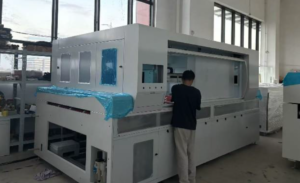Glass coating technology is evolving rapidly, and selecting the right equipment manufacturer is crucial. Making the wrong choice could lead to inefficiencies, increased costs, and lower-quality products.
Choosing the right glass coating equipment manufacturer requires careful consideration of technology, reliability, and long-term support. A well-selected partner ensures efficiency, cost-effectiveness, and high-performance coatings.
Glass coating equipment in a production facility
Finding the right manufacturer can feel overwhelming. In this guide, I'll break down key factors to consider, starting with understanding the glass coating process itself.
How do you coat glass?
Glass surfaces require specialized coating techniques to enhance durability, energy efficiency, and aesthetics. Without proper knowledge, manufacturers risk inconsistent quality and high defect rates.
Glass coating involves applying a thin functional layer using techniques like spray coating, dip coating, or vacuum deposition. The process enhances properties such as UV resistance, thermal insulation, and scratch resistance.
Close-up of glass being coated
Common Glass Coating Methods
Each method has its own advantages and is suited for specific applications. Here's a quick comparison:
| Coating Method | Process Description | Common Applications |
|---|---|---|
| Spray Coating | Uses nozzles to evenly distribute coating material | Automotive glass, anti-fog coatings |
| Dip Coating | Submerges glass in a coating solution, then dries | Optical lenses, hydrophobic coatings |
| Vacuum Deposition | Applies thin films in a controlled vacuum environment | Solar panels, low-E glass, anti-reflective coatings |
Key Considerations When Choosing Coating Equipment
- Coating Uniformity – Ensure consistency in thickness and adhesion.
- Production Speed – Match equipment capabilities with production demands.
- Scalability – Opt for modular systems that grow with business needs.
- Energy Efficiency – Minimize operational costs with optimized power consumption.
Choosing a manufacturer that specializes in your desired coating method is essential for long-term success.
What is the disadvantage of glass coating?
Glass coatings provide many benefits, but they are not without drawbacks. Ignoring these challenges can result in costly inefficiencies and subpar performance.
The main disadvantages of glass coatings include high initial costs, application complexity, and potential durability issues. Selecting the right technology and manufacturer helps mitigate these risks.
Illustration of coating defects
Breaking Down the Challenges
-
High Equipment Costs
- Advanced coating systems require significant upfront investment.
- Low-quality alternatives may result in frequent breakdowns and higher maintenance costs.
-
Application Complexity
- Some coatings require precise environmental conditions (humidity, temperature).
- Operator training is crucial to avoid defects like streaking or peeling.
-
Durability Concerns
- Exposure to harsh conditions can cause coatings to degrade over time.
- Poor adhesion or improper curing can reduce effectiveness.
How to Overcome These Challenges
| Challenge | Solution |
|---|---|
| High initial costs | Choose a manufacturer offering financing or leasing options |
| Application complexity | Opt for user-friendly automation and comprehensive training |
| Durability concerns | Select high-quality raw materials and proven technologies |
A reliable manufacturer will not only supply the equipment but also provide support to address these challenges.
How long does glass coating take to dry?
Understanding drying times is essential for optimizing production efficiency. Delays in curing can lead to bottlenecks and reduced throughput.
Glass coating drying times vary based on the type of coating, environmental conditions, and curing methods. Standard coatings can dry in minutes, while advanced coatings may require hours.
Glass panels drying after coating
Factors Affecting Drying Time
-
Coating Type
- Water-based coatings: Typically dry in 15–30 minutes.
- Solvent-based coatings: Require 30–60 minutes for full evaporation.
- UV-curable coatings: Harden instantly under UV exposure.
-
Environmental Conditions
- Temperature and humidity play a major role in drying speed.
- Proper airflow can reduce drying time significantly.
-
Curing Technology
- Air drying: Slower but cost-effective.
- Oven curing: Faster but energy-intensive.
- UV curing: Almost instantaneous but requires specialized equipment.
Optimizing the Drying Process
- Invest in advanced curing systems – UV or IR curing can significantly cut down drying time.
- Ensure proper ventilation – Airflow management reduces moisture buildup and accelerates evaporation.
- Select fast-drying formulations – Some manufacturers offer proprietary coatings designed for rapid curing.
A well-optimized drying process increases productivity and minimizes downtime, making it a key factor when selecting a glass coating equipment manufacturer.
Conclusion
Selecting the right glass coating equipment manufacturer is a strategic decision. By understanding coating methods, potential challenges, and drying time optimizations, manufacturers can ensure high efficiency, cost-effectiveness, and superior product quality.







